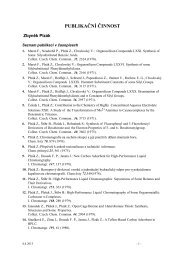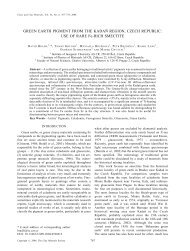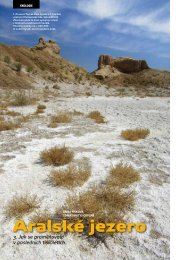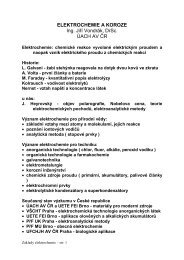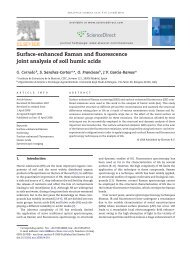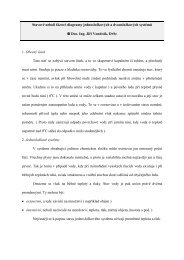Microanalytical identification of Pb-Sb-Sn yellow pigment in ...
Microanalytical identification of Pb-Sb-Sn yellow pigment in ...
Microanalytical identification of Pb-Sb-Sn yellow pigment in ...
Create successful ePaper yourself
Turn your PDF publications into a flip-book with our unique Google optimized e-Paper software.
D. Hradil et al. / Journal <strong>of</strong> Cultural Heritage 8 (2007) 377e386<br />
379<br />
and Naples <strong>yellow</strong> was applied on the superficial layer. For the<br />
direct and unequivocal <strong>identification</strong> <strong>of</strong> the actual composition<br />
<strong>of</strong> pyrochlore-like <strong>Pb</strong>-<strong>yellow</strong>s and differentiation from other<br />
<strong>pigment</strong>s, X-ray diffraction is very useful because the lattice<br />
parameter depends on actual oxide composition [3,11]. Raman<br />
spectroscopy was recently used to dist<strong>in</strong>guish Naples <strong>yellow</strong><br />
and its Si and <strong>Sn</strong> conta<strong>in</strong><strong>in</strong>g analogues [2]. However, a rout<strong>in</strong>e<br />
analysis <strong>of</strong> <strong>Pb</strong>-conta<strong>in</strong><strong>in</strong>g <strong>yellow</strong>s <strong>in</strong> artworks is usually based<br />
only on elemental composition, which is obviously<br />
<strong>in</strong>sufficient.<br />
We have recently identified <strong>Pb</strong>-<strong>Sb</strong>-<strong>Sn</strong> <strong>yellow</strong>s <strong>in</strong> five European<br />
pa<strong>in</strong>t<strong>in</strong>gs from the end <strong>of</strong> 18th and from 19th century.<br />
This dat<strong>in</strong>g and provenance are rather remote with respect to<br />
the well demonstrated usage <strong>of</strong> <strong>Pb</strong>-<strong>Sb</strong>-<strong>Sn</strong>-<strong>yellow</strong> <strong>in</strong> Italian<br />
pa<strong>in</strong>t<strong>in</strong>g <strong>of</strong> 17th century [1,17]. In any case, its relation to<br />
the other <strong>yellow</strong>s is currently unknown, i.e., it is not clear<br />
what caused simultaneous usage <strong>of</strong> Naples and <strong>Pb</strong>-<strong>Sb</strong>-<strong>Sn</strong> <strong>yellow</strong>s.<br />
To try to understand the us<strong>in</strong>g <strong>of</strong> this particular <strong>pigment</strong>,<br />
we synthesized the <strong>Pb</strong>-base <strong>yellow</strong>s and compared their<br />
preparation and colour. It is possible, that the actual composition<br />
<strong>of</strong> the traditional <strong>Pb</strong>-based <strong>yellow</strong>s depended on the actual<br />
accessibility <strong>of</strong> the raw materials, but maybe the <strong>Pb</strong>-<strong>Sb</strong>-<strong>Sn</strong><br />
<strong>yellow</strong> had some technological peculiarity. There is a question<br />
whether its usage could be useful <strong>in</strong> evaluation <strong>of</strong> provenance<br />
and dat<strong>in</strong>g <strong>of</strong> artworks. For the <strong>identification</strong> <strong>of</strong> the <strong>Pb</strong>-based<br />
<strong>yellow</strong>s we used laboratory powder X-ray microdiffraction<br />
[18] that is very suitable to rout<strong>in</strong>e analysis <strong>of</strong> microsamples<br />
<strong>of</strong> artworks.<br />
3. Experimental part<br />
3.1. Laboratory synthesis and characterization <strong>of</strong> <strong>Pb</strong>based<br />
<strong>yellow</strong>s<br />
The <strong>pigment</strong>s were synthesized us<strong>in</strong>g <strong>Pb</strong> 3 O 4 ,<strong>Sb</strong> 2 O 3 ,<strong>Sb</strong> 2 S 3 ,<br />
<strong>Sn</strong>O 2 , NaCl, and K 2 CO 3 <strong>of</strong> analytical purity and SiO 2 <strong>in</strong> the<br />
form <strong>of</strong> silica gel for chromatography. The basic synthesis procedures<br />
were adopted from the literature [2,5,7,15]. In the case<br />
<strong>of</strong> <strong>Sb</strong>-based <strong>yellow</strong>s, some syntheses were facilitated by an<br />
addition <strong>of</strong> flux agents accord<strong>in</strong>g to the literature recipes, where<br />
rock salt NaCl and potash K 2 CO 3 werementionedbyPiccolpasso<br />
(16th century), Mariani (17th century), and Passeri (18th<br />
century) accord<strong>in</strong>g to translations and <strong>in</strong>terpretations by Wa<strong>in</strong>wright<br />
et al. [5], Eastaugh et al. [7], andDiketal.[15], and<br />
SiO 2 by Darduni (17th century) accord<strong>in</strong>g to Sandal<strong>in</strong>as and<br />
Ruiz-Moreno [1]. For X-ray diffraction analysis <strong>of</strong> synthetic<br />
<strong>pigment</strong>s, conventional powder diffractometer D5005 (Bruker)<br />
was used. Colour properties were evaluated us<strong>in</strong>g spectrometer<br />
Lambda 35 (Perk<strong>in</strong> Elmer) equipped with an <strong>in</strong>tegrat<strong>in</strong>g<br />
sphere (Labsphere) for diffuse reflectance measurement. The<br />
spectra were obta<strong>in</strong>ed with <strong>in</strong>tegration sphere set to exclude<br />
the specular reflection and then they were recalculated to<br />
CIE 1964 colour system (10 degree field <strong>of</strong> view) us<strong>in</strong>g s<strong>of</strong>tware<br />
COLOR 3.00 (Perk<strong>in</strong> Elmer). For the visual evaluation <strong>of</strong><br />
the <strong>pigment</strong>s, they were mixed with oil b<strong>in</strong>der (l<strong>in</strong>seed oil,<br />
Kremer Pigmente, Germany) and pa<strong>in</strong>ted on a white ground<br />
layer on wooden plates.<br />
3.2. The artworks and their analyses<br />
A complex materials research <strong>of</strong> 37 easel pa<strong>in</strong>t<strong>in</strong>gs, 3 wall<br />
pa<strong>in</strong>t<strong>in</strong>gs and 4 polychrome artworks conta<strong>in</strong><strong>in</strong>g <strong>Pb</strong>-based<br />
<strong>yellow</strong>s have been made. All the artworks were connected to<br />
Mid-European region either by their orig<strong>in</strong>, location, or authorship.<br />
Five pa<strong>in</strong>t<strong>in</strong>gs were <strong>in</strong>vestigated by non-<strong>in</strong>vasive<br />
X-ray fluorescence analysis prior to sampl<strong>in</strong>g and <strong>in</strong> two <strong>of</strong><br />
them the sampl<strong>in</strong>g <strong>of</strong> <strong>Pb</strong>-based <strong>yellow</strong>s was not allowed by<br />
the artwork owners. Samples were analysed as micr<strong>of</strong>ragments<br />
and their cross-sections by optical microscopy and electron<br />
microscopy with EDS elemental analysis. In 14 cases, powder<br />
X-ray microdiffraction was additionally used for the phase<br />
(m<strong>in</strong>eral) analysis (Table 4). The dat<strong>in</strong>g <strong>of</strong> orig<strong>in</strong>al pa<strong>in</strong>ts<br />
and repa<strong>in</strong>ts with <strong>Pb</strong> <strong>yellow</strong>s was based on <strong>in</strong>terpretation <strong>of</strong><br />
layer stratigraphy with regard<strong>in</strong>g all other results <strong>of</strong> artistic<br />
and historical evaluation <strong>of</strong> pa<strong>in</strong>t<strong>in</strong>gs.<br />
In situ non-<strong>in</strong>vasive <strong>in</strong>vestigation <strong>of</strong> selected pa<strong>in</strong>t<strong>in</strong>gs was<br />
performed by portable X-ray fluorescence spectrometer<br />
provided by MOLAB (MObile LABoratory) through the European<br />
project Eu-ARTECH. It is equipped with a tungsten<br />
anode and a silicon drift detector hav<strong>in</strong>g resolution <strong>of</strong><br />
w130 eV at 5.9 KeV. Element mapp<strong>in</strong>g (Z > 13) with a spatial<br />
resolution <strong>of</strong> 4 mm was achievable.<br />
Cross-sections <strong>of</strong> colour layers were studied after embedd<strong>in</strong>g<br />
<strong>in</strong> polyester res<strong>in</strong> and cross section<strong>in</strong>g. Optical microscopy<br />
(Olympus BX-60 <strong>in</strong> reflected visible light and UVA light <strong>in</strong><br />
the wavelength range <strong>of</strong> 330e380 nm), and electron microscopy<br />
(Philips XL-30 CP) with RBS detector <strong>of</strong> back-scattered<br />
electrons and EDS analyser was used to describe the layer<br />
stratigraphy and elemental composition <strong>of</strong> <strong>yellow</strong> <strong>pigment</strong><br />
gra<strong>in</strong>s <strong>in</strong> cross-sections whenever the sampl<strong>in</strong>g <strong>of</strong> colour layer<br />
was allowed. Micro-X-ray diffractometer X’PertPro (PANalytical)<br />
with 0.15 mm diameter <strong>of</strong> the primary beam was used to<br />
the phase analysis <strong>of</strong> micr<strong>of</strong>ragments (



